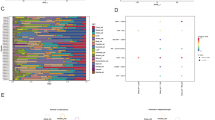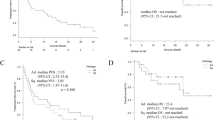Abstract
There is no robust genomic signature to predict the prognosis of patients with early-stage lung adenocarcinoma (LUAD). It was known that clonal heterogeneity was closely associated to tumour progression and prognosis prediction. Herein, using stage I patients from The Cancer Genome Atlas, we identified the clonal/subclonal events of each gene and preselected a set of genes with prognosis-specific mutation patterns based on a robust published transcriptomic prognostic signature. Subsequently, we constructed a mutational prognostic signature (MPS), whose prognostic performance was independently validated in two datasets of stage I samples. The predicted high-risk patients had significantly higher immune cell infiltration, along with higher expression of cytotoxic and immune checkpoint genes, and an integrated dataset with 88 samples confirmed that high-risk patients could benefit from immunotherapy. The developed MPS can identify the high-risk patients with stage I LUAD and improve individualised treatment planning of high-risk patients who might benefit from immunotherapy.
Key messages
-
We creatively developed a prognostic signature (57-MPS) based on clonal diversity.
-
The high-risk samples displayed an underlying immunosuppressive mechanism.
-
57-MPS improved the predictive performance of PD-L1 for immunotherapy.





Similar content being viewed by others
Data availability
All the data used in this study are publicly available.
References
Perrier ND, Brierley JD, Tuttle RM (2018) Differentiated and anaplastic thyroid carcinoma: major changes in the American Joint Committee on Cancer eighth edition cancer staging manual. CA Cancer J Clin 68(1):55–63. https://doi.org/10.3322/caac.21439
Morgensztern D, Du L, Waqar SN, Patel A, Samson P, Devarakonda S, Gao F, Robinson CG, Bradley J, Baggstrom M et al (2016) Adjuvant chemotherapy for patients with T2N0M0 NSCLC. J Thorac Oncol 11(10):1729–1735. https://doi.org/10.1016/j.jtho.2016.05.022
Wang HL, Liu PF, Yue J, Jiang WH, Cui YL, Ren H, Wang H, Zhuang Y, Liu Y, Jiang D et al (2020) Somatic gene mutation signatures predict cancer type and prognosis in multiple cancers with pan-cancer 1000 gene panel. Cancer Lett 470:181–190. https://doi.org/10.1016/j.canlet.2019.11.022
Jamal-Hanjani M, Wilson GA, McGranahan N, Birkbak NJ, Watkins TBK, Veeriah S, Shafi S, Johnson DH, Mitter R, Rosenthal R et al (2017) Tracking the evolution of non-small-cell lung cancer. N Engl J Med 376(22):2109–2121. https://doi.org/10.1056/NEJMoa1616288
Isaeva OI, Sharonov GV, Serebrovskaya EO, Turchaninova MA, Zaretsky AR, Shugay M, Chudakov DM (2019) Intratumoral immunoglobulin isotypes predict survival in lung adenocarcinoma subtypes. J Immunother Cancer 7(1):279. https://doi.org/10.1186/s40425-019-0747-1
Xu ZH, Wang H, Ji XY, Zhang FX, Gao BL, Hu JA, Zheng J (2019) A detrimental mutation on USP40 unlocks the tumorigenesis in a rare case of lung cancer. Int J Clin Exp Pathol 12(3):740–749. https://www.ncbi.nlm.nih.gov/pubmed/31933881
Shi J, Hua X, Zhu B, Ravichandran S, Wang M, Nguyen C, Brodie SA, Palleschi A, Alloisio M, Pariscenti G et al (2016) Somatic genomics and clinical features of lung adenocarcinoma: a retrospective study. PLoS Med 13(12):e1002162. https://doi.org/10.1371/journal.pmed.1002162
Nadeu F, Delgado J, Royo C, Baumann T, Stankovic T, Pinyol M, Jares P, Navarro A, Martin-Garcia D, Bea S et al (2016) Clinical impact of clonal and subclonal TP53, SF3B1, BIRC3, NOTCH1, and ATM mutations in chronic lymphocytic leukemia. Blood 127(17):2122–2130. https://doi.org/10.1182/blood-2015-07-659144
Williams MJ, Werner B, Heide T, Curtis C, Barnes CP, Sottoriva A, Graham TA (2018) Quantification of subclonal selection in cancer from bulk sequencing data. Nat Genet 50(6):895–903. https://doi.org/10.1038/s41588-018-0128-6
Menor M, Zhu Y, Wang Y, Zhang J, Jiang B, Deng Y (2019) Development of somatic mutation signatures for risk stratification and prognosis in lung and colorectal adenocarcinomas. BMC Med Genomics 12(Suppl 1):24. https://doi.org/10.1186/s12920-018-0454-7
Geng H, Li S, Guo Y, Yan F, Han Y, Xu M, Cui Y (2020) Survival prediction for patients with lung adenocarcinoma: a prognostic risk model based on gene mutations. Cancer Biomark 27(4):525–532. https://doi.org/10.3233/CBM-191204
Wang F, Zhao N, Gao G, Deng HB, Wang ZH, Deng LL, Yang Y, Lu C (2020) Prognostic value of TP53 co-mutation status combined with EGFR mutation in patients with lung adenocarcinoma. J Cancer Res Clin Oncol 146(11):2851–2859. https://doi.org/10.1007/s00432-020-03340-5
Zhang Z, Zhang S, Li X, Zhao Z, Chen C, Zhang J, Li M, Wei Z, Jiang W, Pan B et al (2021) Reference genome and annotation updates lead to contradictory prognostic predictions in gene expression signatures: a case study of resected stage I lung adenocarcinoma. Brief Bioinform 22(3). https://doi.org/10.1093/bib/bbaa081
Hellmann MD, Nathanson T, Rizvi H, Creelan BC, Sanchez-Vega F, Ahuja A, Ni A, Novik JB, Mangarin LMB, Abu-Akeel M et al (2018) Genomic features of response to combination immunotherapy in patients with advanced non-small-cell lung cancer. Cancer Cell 33(5):843–852 e844. https://doi.org/10.1016/j.ccell.2018.03.018
Rizvi NA, Hellmann MD, Snyder A, Kvistborg P, Makarov V, Havel JJ, Lee W, Yuan J, Wong P, Ho TS et al (2015) Cancer immunology. Mutational landscape determines sensitivity to PD-1 blockade in non-small cell lung cancer. Science 348(6230):124–128. https://doi.org/10.1126/science.aaa1348
Strickler JH, Loree JM, Ahronian LG, Parikh AR, Niedzwiecki D, Pereira AAL, McKinney M, Korn WM, Atreya CE, Banks KC et al (2018) Genomic landscape of cell-free DNA in patients with colorectal cancer. Cancer Discov 8(2):164–173. https://doi.org/10.1158/2159-8290.CD-17-1009
Youden WJ (1950) Index for rating diagnostic tests. Cancer 3(1):32–35. https://doi.org/10.1002/1097-0142(1950)3:1%3c32::aid-cncr2820030106%3e3.0.co;2-3
Pencina MJ, D'Agostino RB Sr, D'Agostino RB Jr, Vasan RS (2008) Evaluating the added predictive ability of a new marker: from area under the ROC curve to reclassification and beyond. Stat Med 27(2):157–172; discussion 207–112. https://doi.org/10.1002/sim.2929
Pencina MJ, D’Agostino RB Sr, Steyerberg EW (2011) Extensions of net reclassification improvement calculations to measure usefulness of new biomarkers. Stat Med 30(1):11–21. https://doi.org/10.1002/sim.4085
Whitfield ML, George LK, Grant GD, Perou CM (2006) Common markers of proliferation. Nat Rev Cancer 6(2):99–106. https://doi.org/10.1038/nrc1802
Zheng H, Song K, Fu Y, You T, Yang J, Guo W, Wang K, Jin L, Gu Y, Qi L et al (2021) An absolute human stemness index associated with oncogenic dedifferentiation. Brief Bioinform 22(2):2151–2160. https://doi.org/10.1093/bib/bbz174
Eustace A, Mani N, Span PN, Irlam JJ, Taylor J, Betts GN, Denley H, Miller CJ, Homer JJ, Rojas AM et al (2013) A 26-gene hypoxia signature predicts benefit from hypoxia-modifying therapy in laryngeal cancer but not bladder cancer. Clin Cancer Res 19(17):4879–4888. https://doi.org/10.1158/1078-0432.CCR-13-0542
Hochberg Y, Benjamini Y (1990) More powerful procedures for multiple significance testing. Stat Med 9(7):811–818. https://doi.org/10.1002/sim.4780090710
Zhang W, Lin X, Li X, Wang M, Sun W, Han X, Sun D (2020) Survival prediction model for non-small cell lung cancer based on somatic mutations. J Gene Med 22(9):e3206. https://doi.org/10.1002/jgm.3206
Wasserstein RL, Schirm AL, Lazar NA (2019) Moving to a world beyond “p < 0.05”. Am Stat 73(sup1):1–19. https://doi.org/10.1080/00031305.2019.1583913
Lo A, Chernoff H, Zheng T, Lo SH (2015) Why significant variables aren’t automatically good predictors. Proc Natl Acad Sci U S A 112(45):13892–13897. https://doi.org/10.1073/pnas.1518285112
Boyer AS, Walter D, Sorensen CS (2016) DNA replication and cancer: from dysfunctional replication origin activities to therapeutic opportunities. Semin Cancer Biol 37–38:16–25. https://doi.org/10.1016/j.semcancer.2016.01.001
Brown JS, O’Carrigan B, Jackson SP, Yap TA (2017) Targeting DNA repair in cancer: beyond PARP inhibitors. Cancer Discov 7(1):20–37. https://doi.org/10.1158/2159-8290.CD-16-0860
Wang S, He Z, Wang X, Li H, Liu XS (2019) Antigen presentation and tumor immunogenicity in cancer immunotherapy response prediction. Elife 8. https://doi.org/10.7554/eLife.49020
Jones GD, Brandt WS, Shen R, Sanchez-Vega F, Tan KS, Martin A, Zhou J, Berger M, Solit DB, Schultz N et al (2021) A genomic-pathologic annotated risk model to predict recurrence in early-stage lung adenocarcinoma. JAMA Surg 156(2):e205601. https://doi.org/10.1001/jamasurg.2020.5601
Yang L, He YT, Dong S, Wei XW, Chen ZH, Zhang B, Chen WD, Yang XR, Wang F, Shang XM et al (2022) Single-cell transcriptome analysis revealed a suppressive tumor immune microenvironment in EGFR mutant lung adenocarcinoma. J Immunother Cancer 10(2). https://doi.org/10.1136/jitc-2021-003534
Jia Q, Chiu L, Wu S, Bai J, Peng L, Zheng L, Zang R, Li X, Yuan B, Gao Y et al (2020) Tracking neoantigens by personalized circulating tumor DNA sequencing during checkpoint blockade immunotherapy in non-small cell lung cancer. Adv Sci (Weinh) 7(9):1903410. https://doi.org/10.1002/advs.201903410
Newman AM, Steen CB, Liu CL, Gentles AJ, Chaudhuri AA, Scherer F, Khodadoust MS, Esfahani MS, Luca BA, Steiner D et al (2019) Determining cell type abundance and expression from bulk tissues with digital cytometry. Nat Biotechnol 37(7):773–782. https://doi.org/10.1038/s41587-019-0114-2
Miyazaki T, Ishikawa E, Sugii N, Matsuda M (2020) Therapeutic strategies for overcoming immunotherapy resistance mediated by immunosuppressive factors of the glioblastoma microenvironment. Cancers (Basel) 12(7). https://doi.org/10.3390/cancers12071960
Biswas S, Mandal G, Roy Chowdhury S, Purohit S, Payne KK, Anadon C, Gupta A, Swanson P, Yu X, Conejo-Garcia JR et al (2019) Exosomes produced by mesenchymal stem cells drive differentiation of myeloid cells into immunosuppressive M2-polarized macrophages in breast cancer. J Immunol 203(12):3447–3460. https://doi.org/10.4049/jimmunol.1900692
Hugo W, Zaretsky JM, Sun L, Song C, Moreno BH, Hu-Lieskovan S, Berent-Maoz B, Pang J, Chmielowski B, Cherry G et al (2016) Genomic and transcriptomic features of response to anti-PD-1 therapy in metastatic melanoma. Cell 165(1):35–44. https://doi.org/10.1016/j.cell.2016.02.065
Ayers M, Lunceford J, Nebozhyn M, Murphy E, Loboda A, Kaufman DR, Albright A, Cheng JD, Kang SP, Shankaran V et al (2017) IFN-gamma-related mRNA profile predicts clinical response to PD-1 blockade. J Clin Invest 127(8):2930–2940. https://doi.org/10.1172/JCI91190
Ding L, Ley TJ, Larson DE, Miller CA, Koboldt DC, Welch JS, Ritchey JK, Young MA, Lamprecht T, McLellan MD et al (2012) Clonal evolution in relapsed acute myeloid leukaemia revealed by whole-genome sequencing. Nature 481(7382):506–510. https://doi.org/10.1038/nature10738
Zhou Z, He H, Wang K, Shi X, Wang Y, Su Y, Wang Y, Li D, Liu W, Zhang Y et al (2020) Granzyme A from cytotoxic lymphocytes cleaves GSDMB to trigger pyroptosis in target cells. Science 368(6494). https://doi.org/10.1126/science.aaz7548
Funding
This study was supported by grants from the National Natural Science Foundation of China (81872396 to LQ, 32270710 to YG), HMU Marshal Initiative Funding (No. HMUMIF-21023 to LQ) and the Postdoctoral Scientific Research Developmental Fund (grant number LBH-Q16166 to YG).
Author information
Authors and Affiliations
Contributions
Lishuang Qi and Yunyan Gu contributed to the study concept and design. Sainan Zhang and Mengyue Li contributed to the data collection and analysed the data. Yilong Tan, Juxuan Zhang, Yixin Liu and Wenbin Jiang provided the methods of statistical analyses. Lishuang Qi and Sainan Zhang drafted the paper. Xin Li, Haitao Qi, Lefan Tang, Ran Ji and Wenyuan Zhao provided comments and improvements to the paper. All authors read and approved the final manuscript.
Corresponding authors
Ethics declarations
Ethics approval and consent to participate
Not applicable.
Competing interests
The authors declare no competing interests.
Additional information
Publisher's Note
Springer Nature remains neutral with regard to jurisdictional claims in published maps and institutional affiliations.
Supplementary Information
Below is the link to the electronic supplementary material.
Rights and permissions
Springer Nature or its licensor (e.g. a society or other partner) holds exclusive rights to this article under a publishing agreement with the author(s) or other rightsholder(s); author self-archiving of the accepted manuscript version of this article is solely governed by the terms of such publishing agreement and applicable law.
About this article
Cite this article
Zhang, S., Li, M., Tan, Y. et al. Identification of mutational signature for lung adenocarcinoma prognosis and immunotherapy prediction. J Mol Med 100, 1755–1769 (2022). https://doi.org/10.1007/s00109-022-02266-4
Received:
Revised:
Accepted:
Published:
Issue Date:
DOI: https://doi.org/10.1007/s00109-022-02266-4




